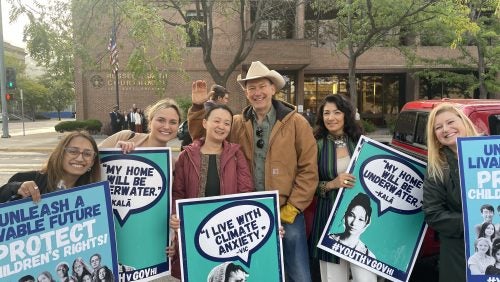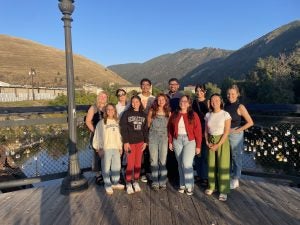HRI Practicum Students Travel to Montana to Witness Human Rights Arguments in Landmark Climate Case
September 24, 2025

HRI Practicum supervisors and students outside the courthouse in Missoula, Montana.
Last week, The New York Times reported on Lighthiser v. Trump, a high-stakes challenge to three executive orders expanding fossil fuel use. Just days later, students in the Human Rights Advocacy in Action Practicum were in the Missoula, Montana federal courthouse watching one of the boldest constitutional climate lawsuits yet unfold in real time.
The practicum, taught by Michelle Liu, Awista Ayazi, and Melody Vidmar, is partnering this year with Our Children’s Trust (“OCT”), a non-profit public interest law firm representing the Lighthiser plaintiffs, to support their mission to secure the human rights of children to a healthy environment through strategic litigation. For students, the two-day evidentiary hearing was an extraordinary experiential learning opportunity, connecting their intensive classroom studies with the realities of strategic litigation and the lived experiences of youth on the frontlines of climate change.
The testimony youth plaintiffs gave was powerful and personal. Five young people—two living with severe lung conditions—detailed how wildfire smoke, coal dust, and intensifying heat and floods were already shaping their health, safety, and livelihoods. One described caring for her horse during devastating wildfires in Oregon and later being forced to evacuate during hurricanes in Florida, experiences that left her uncertain about whether she even had a future worth planning. Each spoke to the harms they were enduring now and the fear of a future destabilized by government-driven fossil fuel expansion.
Expert witnesses—including Stanford engineer Mark Z. Jacobson, Columbia economist Geoffrey Heal, and longtime climate policy leader and Georgetown Law professor John Podesta—reinforced these stories with data. They testified to the health and economic costs of fossil fuel expansion, the climate benefits of renewable energy, and the dangers of dismantling climate science at the federal level. Together, their evidence bolstered the argument that the government does not have a compelling reason to infringe upon plaintiffs’ constitutional rights to life and liberty.
Government lawyers countered that the case was political overreach, arguing that energy policy should be left to elected officials. They likened the case to Juliana v. United States, an earlier OCT case that was ultimately dismissed by the Ninth Circuit Court of Appeals, which said that the judiciary was not the proper forum for the case. Plaintiffs both distinguished the cases from one another and reminded this court of the very real harms they face from climate change—harms being exacerbated by the current administration’s challenged orders.
For students, the experience went beyond observing constitutional arguments.  They saw how youth narratives, expert science, and advocacy strategy converge in climate litigation, as well as how storytelling in the courtroom can help shape law and public opinion.
They saw how youth narratives, expert science, and advocacy strategy converge in climate litigation, as well as how storytelling in the courtroom can help shape law and public opinion.
“As students, it’s really important that we learn about all aspects of litigation and how to make strategic litigation work in the world today,” said Navin Rana (L’27).
Dash-Muse Teaching Fellow Melody Vidmar added, “seeing the youth plaintiffs and the experts educate the court and tell their stories was a masterclass in storytelling through litigation, not just for the students, but for me, too.”
The experience will inform the students’ work throughout the year in the Human Rights Advocacy in Action Practicum, as they continue examining how litigation can be used to defend fundamental rights in the face of global challenges like the climate crisis.
Written by Edie Tepper
